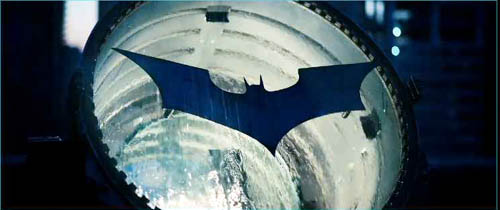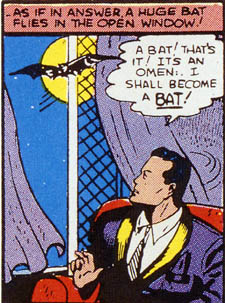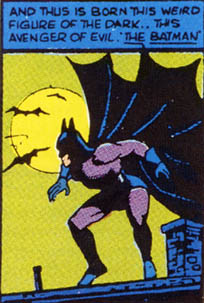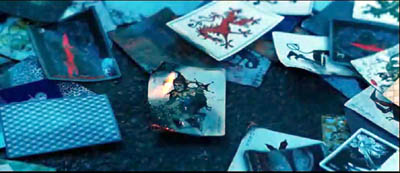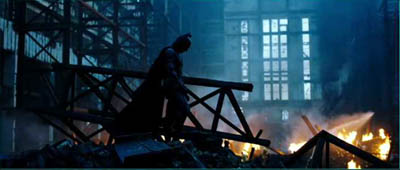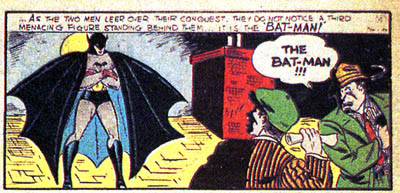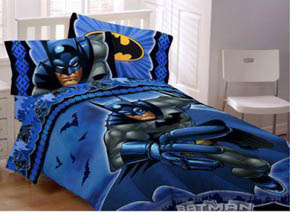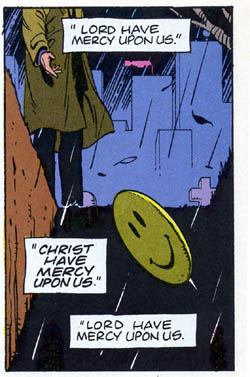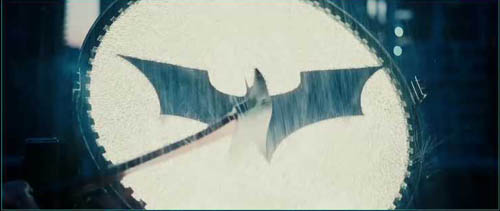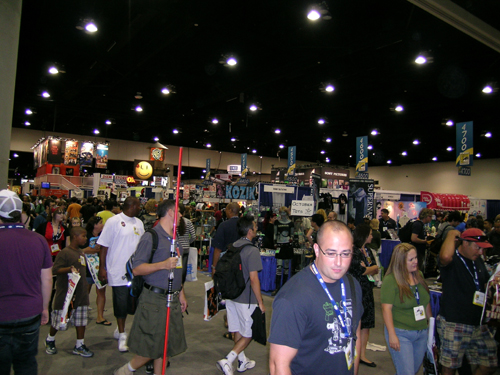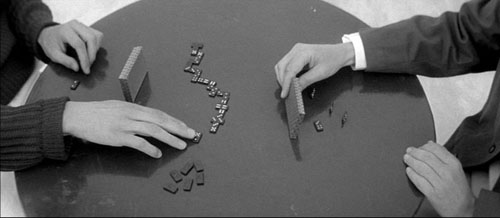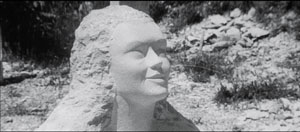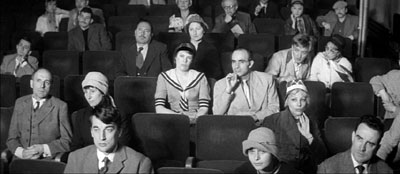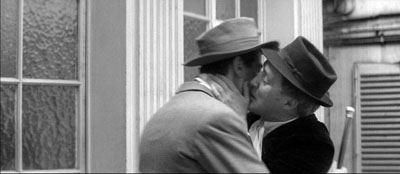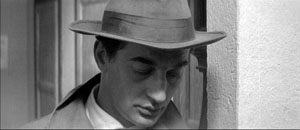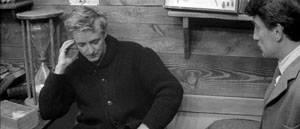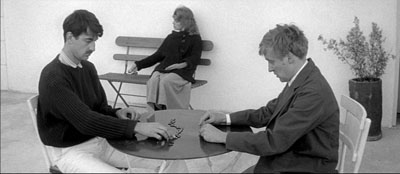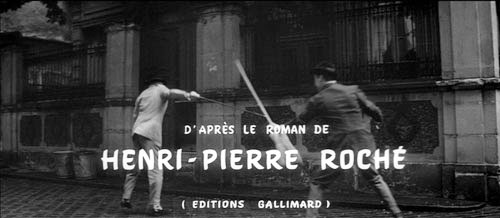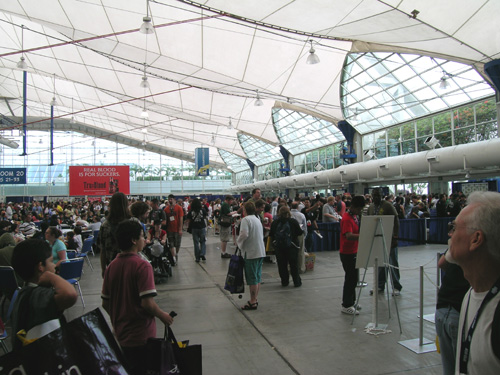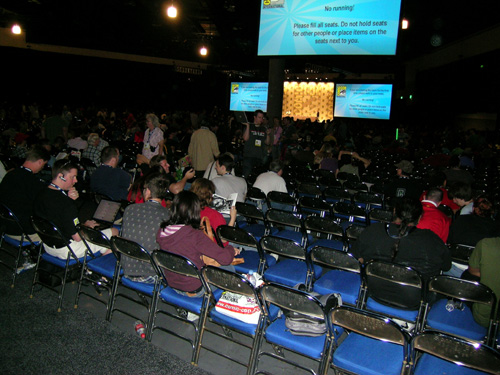Archive for 2008
Superheroes for sale
DB here:
After a day at the movies, maybe I am living in a parallel universe. I go to see two films praised by people whose tastes I respect. I find myself bored and depressed. I’m also asking questions.
Over the twenty years since Batman (1989), and especially in the last decade or so, some tentpole pictures, and many movies at lower budget levels, have featured superheroes from the Golden and Silver age of comic books. By my count, since 2002, there have been between three and seven comic-book superhero movies released every year. (I’m not counting other movies derived from comic books or characters, like Richie Rich or Ghost World.)
Until quite recently, superheroes haven’t been the biggest money-spinners. Only eleven of the top 100 films on Box Office Mojo’s current worldwide-grosser list are derived from comics, and none ranks in the top ten titles. But things are changing. For nearly every year since 2000, at least one title has made it into the list of top twenty worldwide grossers. For most years two titles have cracked this list, and in 2007 there were three. This year three films have already arrived in the global top twenty: The Dark Knight, Iron Man, and The Incredible Hulk (four, if you count Wanted as a superhero movie).
This 2008 successes have vindicated Marvel’s long-term strategy to invest directly in movies and have spurred Warners to slate more comic-book titles. David S. Cohen analyses this new market here. So we are clearly in the midst of a Trend. My trip to the multiplex got me asking: What has enabled superhero comic-book movies to blast into a central spot in today’s blockbuster economy?
Enter the comic-book guys
It’s clearly not due to a boom in comic-book reading. Superhero books have not commanded a wide audience for a long time. Statistics on comic-book readership are closely guarded, but the expert commentator John Jackson Miller reports that back in 1959, at least 26 million comic books were sold every month. In the highest month of 2006, comic shops ordered, by Miller’s estimate, about 8 million books (and this total includes not only periodical comics but graphic novels, independent comics, and non-superhero titles). There have been upticks and downturns over the decades, but the overall pattern is a steep slump.
Try to buy an old-fashioned comic book, with staples and floppy covers, and you’ll have to look hard. You can get albums and graphic novels at the chain stores like Borders, but not the monthly periodicals. For those you have to go to a comics shop, and Hank Luttrell, one of my local purveyors of comics, estimates there aren’t more than 1000 of them in the U. S.
Moreover, there’s still a stigma attached to reading superhero comics. Even kitsch novels have long had a slightly higher cultural standing than comic books. Admitting you had read The Devil Wears Prada would be less embarrassing than admitting you read Daredevil.
For such reasons and others, the audience for superhero comics is far smaller than the audience for superhero movies. The movies seem to float pretty free of their origins; you can imagine a young Spider-Man fan who loved the series but never knew the books. What’s going on?
Men in tights, and iron pants
The films that disappointed me on that moviegoing day were Iron Man and The Dark Knight. The first seemed to me an ordinary comic-book movie endowed with verve by Robert Downey Jr.’s performance. While he’s thought of as a versatile actor, Downey also has a star persona—the guy who’s wound a few turns too tight, putting up a good front with rapid-fire patter (see Home for the Holidays, Wonder Boys, Kiss Kiss Bang Bang, Zodiac). Downey’s cynical chatterbox makes Iron Man watchable. When he’s not onscreen we get excelsior.
Christopher Nolan showed himself a clever director in Memento and a promising one in The Prestige. So how did he manage to make The Dark Knight such a portentously hollow movie? Apart from enjoying seeing Hong Kong in Imax, I was struck by the repetition of gimmicky situations–disguises, hostage-taking, ticking bombs, characters dangling over a skyscraper abyss, who’s dead really once and for all? The fights and chases were as unintelligible as most such sequences are nowadays, and the usual roaming-camera formulas were applied without much variety. Shoot lots of singles, track slowly in on everybody who’s speaking, spin a circle around characters now and then, and transition to a new scene with a quick airborne shot of a cityscape. Like Jim Emerson, I thought that everything hurtled along at the same aggressive pace. If I want an arch-criminal caper aiming for shock, emotional distress, and political comment, I’ll take Benny Chan’s New Police Story.
Then there are the mouths. This is a movie about mouths. I couldn’t stop staring at them. Given Batman’s cowl and his husky whisper, you practically have to lip-read his lines. Harvey Dent’s vagrant facial parts are especially engaging around the jaws, and of course the Joker’s double rictus dominates his face. Gradually I found Maggie Gyllenhaal’s spoonbill lips starting to look peculiar.
The expository scenes were played with a somber knowingness I found stifling. Quoting lame dialogue is one of the handiest weapons in a critic’s arsenal and I usually don’t resort to it; many very good movies are weak on this front. Still, I can’t resist feeling that some weighty lines were doing duty for extended dramatic development, trying to convince me that enormous issues were churning underneath all the heists, fights, and chases. Know your limits, Master Wayne. Or: Some men just want to watch the world burn. Or: In their last moments people show you who they really are. Or: The night is darkest before the dawn.
I want to ask: Why so serious?
Odds are you think better of Iron Man and The Dark Knight than I do. That debate will go on for years. My purpose here is to explore a historical question: Why comic-book superhero movies now?
Z as in Zeitgeist
More superhero movies after 2002, you say? Obviously 9/11 so traumatized us that we feel a yearning for superheroes to protect us. Our old friend the zeitgeist furnishes an explanation. Every popular movie can be read as taking the pulse of the public mood or the national unconscious.
I’ve argued against zeitgeist readings in Poetics of Cinema, so I’ll just mention some problems with them:
*A zeitgeist is hard to pin down. There’s no reason to think that the millions of people who go to the movies share the same values, attitudes, moods, or opinions. In fact, all the measures we have of these things show that people differ greatly along all these dimensions. I suspect that the main reason we think there’s a zeitgeist is that we can find it in popular culture. But we would need to find it independently, in our everyday lives, to show that popular culture reflects it.
*So many different movies are popular at any moment that we’d have to posit a pretty fragmented national psyche. Right now, it seems, we affirm heroic achievement (Indiana Jones and the Kingdom of the Crystal Skull, Kung Fu Panda, Prince Caspian) except when we don’t (Get Smart, The Dark Knight). So maybe the zeitgeist is somehow split? That leads to vacuity, since that answer can accommodate an indefinitely large number of movies. (We’d have to add fractions of our psyche that are solicited by Sex and the City and Horton Hears a Who!)
*The movie audience isn’t a good cross-section of the general public. The demographic profile tilts very young and moderately affluent. Movies are largely a middle-class teenage and twentysomething form. When a producer says her movie is trying to catch the zeitgeist, she’s not tracking retired guys in Arizona wearing white belts; she’s thinking mostly of the tastes of kids in baseball caps and draggy jeans.
* Just because a movie is popular doesn’t mean that people have found the same meanings in it that critics do. Interpretation is a matter of constructing meaning out of what a movie puts before us, not finding the buried treasure, and there’s no guarantee that the critic’s construal conforms to any audience member’s.
*Critics tend to think that if a movie is popular, it reflects the populace. But a ticket is not a vote for the movie’s values. I may like or dislike it, and I may do either for reasons that have nothing to do with its projection of my hidden anxieties.
*Many Hollywood films are popular abroad, in nations presumably possessing a different zeitgeist or national unconscious. How can that work? Or do audiences on different continents share the same zeitgeist?
Wait, somebody will reply, The Dark Knight is a special case! Nolan and his collaborators have strewn the film with references to post-9/11 policies about torture and surveillance. What, though, is the film saying about those policies? The blogosphere is already ablaze with discussions of whether the film supports or criticizes Bush’s White House. And the Editorial Board of the good, gray Times has noticed:
It does not take a lot of imagination to see the new Batman movie that is setting box office records, The Dark Knight, as something of a commentary on the war on terror.
You said it! Takes no imagination at all. But what is the commentary? The Board decides that the water is murky, that some elements of the movie line up on one side, some on the other. The result: “Societies get the heroes they deserve,” which is virtually a line from the movie.
I remember walking out of Patton (1970) with a hippie friend who loved it. He claimed that it showed how vicious the military was, by portraying a hero as an egotistical nutcase. That wasn’t the reading offered by a veteran I once talked to, who considered the film a tribute to a great warrior.
It was then I began to suspect that Hollywood movies are usually strategically ambiguous about politics. You can read them in a lot of different ways, and that ambivalence is more or less deliberate.
A Hollywood film tends to pose sharp moral polarities and then fuzz or fudge or rush past settling them. For instance, take The Bourne Ultimatum: Yes, the espionage system is corrupt, but there is one honorable agent who will leak the information, and the press will expose it all, and the malefactors will be jailed. This tactic hasn’t had a great track record in real life.
The constitutive ambiguity of Hollywood movies helpfully disarms criticisms from interest groups (“Look at the positive points we put in”). It also gives the film an air of moral seriousness (“See, things aren’t simple; there are gray areas”). That’s the bait the Times writers took.
I’m not saying that films can’t carry an intentional message. Bryan Singer and Ian McKellen claim the X-Men series criticizes prejudice against gays and minorities. Nor am I saying that an ambivalent film comes from its makers delicately implanting counterbalancing clues. Sometimes they probably do. More often, I think, filmmakers pluck out bits of cultural flotsam opportunistically, stirring it all together and offering it up to see if we like the taste. It’s in filmmakers’ interests to push a lot of our buttons without worrying whether what comes out is a coherent intellectual position. Patton grabbed people and got them talking, and that was enough to create a cultural event. Ditto The Dark Knight.
Back to basics
If the zeitgeist doesn’t explain the flourishing of the superhero movie in the last few years, what does? I offer some suggestions. They’re based on my hunch that the genre has brought together several trends in contemporary Hollywood film. These trends, which can commingle, were around before 2000, but they seem to be developing in a way that has created a niche for the superhero film.
The changing hierarchy of genres. Not all genres are created equal, and they rise or fall in status. As the Western and the musical fell in the 1970s, the urban crime film, horror, and science-fiction rose. For a long time, it would be unthinkable for an A-list director to do a horror or science-fiction movie, but that changed after Polanski, Kubrick, Ridley Scott, et al. gave those genres a fresh luster just by their participation. More recently, I argue in The Way Hollywood Tells It, the fantasy film arrived as a respectable genre, as measured by box-office receipts, critical respect, and awards. It seems that the sword-and-sorcery movie reached its full rehabilitation when The Lord of the Rings: The Return of the King scored its eleven Academy Awards.
The comic-book movie has had a longer slog from the B- and sub-B-regions. Superman, Flash Gordon, and Dick Tracy were all fodder for serials and low-budget fare. Prince Valiant (1954) was the only comics-derived movie of any standing in the 1950s, as I recall, and you can argue that it fitted into a cycle of widescreen costume pictures. (Though it looks like a pretty camp undertaking today.) Much later came revivals of the two most popular superheroes, Superman (1978) and Batman (1989).
The success of the Batman film, which was carefully orchestrated by Warners and its DC comics subsidiary, can be seen as preparing the grounds for today’s superhero franchises. The idea was to avoid simply reiterating a series, as the Superman movie did, or mocking it, as the Batman TV show did. The purpose was to “reimagine” the series, to “reboot” it as we now say, the way Frank Miller’s The Dark Knight Returns re-launched the Batman comic. Rebooting modernizes the mythos by reinterpreting it in a thematically serious and graphically daring way.
During the 1990s, less famous superheroes filled in as the Batman franchise tailed off. Examples were The Rocketeer (1991), Timecop (1994), The Crow (1994) and The Crow: City of Angels (1996), Judge Dredd (1995), Men in Black (1997), Spawn (1997), Blade (1998), and Mystery Men (1999). Most of these managed to fuse their appeals with those of another parvenu genre, the kinetic action-adventure movie.
Significantly, these were typically medium-budget films from semi-independent companies. Although some failed, a few were huge and many earned well, especially once home video was reckoned in. Moreover, the growing number of titles, sometimes featuring name actors, fueled a sense that this genre was becoming important. As often happens, marginal companies developed the market more nimbly than the big ones, who tend to move in once the market has matured.
I’d also suggest that The Matrix (1999) helped legitimize the cycle. (Neo isn’t a superhero? In the final scene he can fly.) The pseudophilosophical aura this movie radiated, as well as its easy familiarity with comics, videogames, and the Web, made it irrevocably cool. Now ambitious young directors like Nolan, Singer, and Brett Ratner could sign such projects with no sense they were going downmarket.
The importance of special effects. Arguably there were no fundamental breakthroughs in special-effects technology from the 1940s to the 1960s. But with motion-control cinematography, showcased in the first Star Wars installment (1977) filmmakers could create a new level of realism in the use of miniatures. Later developments in matte work, blue- and green-screen techniques, and digital imagery were suited to, and driven by, the other genres that were on the rise—horror, science-fiction, and fantasy—but comic-book movies benefited as well. The tagline for Superman was “You’ll believe a man can fly.”
Special effects thereby became one of a film’s attractions. Instead of hiding the technique, films flaunted it as a mark of big budgets and technological sophistication. The fantastic powers of superheroes cried out for CGI, and it may be that convincing movies in the genre weren’t really ready until the software matured.
The rise of franchises. Studios have always sought predictability, and the classic studio system relied on stars and genres to encourage the audience to return for more of what it liked. But as film attendance waned, producers looked for other models. One that was successful was the branded series, epitomized in the James Bond films. With the rise of the summer blockbuster, producers searched for properties that could be exploited in a string of movies. A memorable character could tie the installments together, and so filmmakers turned to pop literature (e.g., the Harry Potter books) and comic books. Today, Marvel Enterprises is less concerned with publishing comics than with creating film vehicles for its 5000 characters. Indeed, to get bank financing it put up ten of its characters as collateral!
Yet a single character might not sustain a robust franchise. Henry Jenkins has written about how popular culture is gravitating to multi-character “worlds” that allow different media texts to be carved out of them. Now that periodical sales of comics have flagged, the tail is wagging the dog. The 5000 characters in the Marvel Universe furnish endless franchise opportunities. If you stayed for the credit cookie at the end of Iron Man, you saw the setup for a sequel that will pair the hero with at least one more Marvel protagonist.
Merchandising and corporate synergy. It’s too obvious to dwell on, but superhero movies fit neatly into the demand that franchises should spawn books, TV shows, soundtracks, toys, apparel, and so on. Time Warner’s acquisition of DC Comics was crucial to the cross-platform marketing of the first Batman. Moreover, most comics readers are relatively affluent (a big change from my boyhood), so they have the income to buy action figures and other pricy collectibles, like a Batbed.
The shift from an auteur cinema to a genre cinema. The classic studio system maintained a fruitful, sometimes tense, balance between directorial expression and genre demands. Somewhere in recent decades that balance has split into polarities. We now have big-budget genre films that made by directors of no discernible individuality, and small “personal” films that showcase the director’s sensibility. There have always been impersonal craftsmen in Hollywood, but the most distinctive directors could often bring their own sensibilities to projects big or small.
David Lynch could make Dune (1984) part of his own oeuvre, but since then we have many big-budget genre pictures that bear no signs of directorial individuality. In particular, science-fiction, fantasy, and superhero movies demand so much high-tech input, so much preparation, so many logistical tasks in shooting, and such intensive postproduction, that economy of effort favors a standardized look and feel. Hence perhaps the recourse to well-established techniques of shooting and cutting; intensified continuity provides a line of least resistance. A comic-book movie can succeed if it doesn’t stray from the fanbase’s expectations and swiftly initiates the newbies. Not much directorial finesse is needed, as 300 (2007) shows.
The development of the megapicture may have led the more talented directors to the “one for them, one for me” motto. Think of the difference between Burton’s Planet of the Apes or even Sweeney Todd and, say, Ed Wood or Big Fish. Or think of the moments of elegance in Memento and The Prestige, as opposed to the blunt handling of Batman Begins and The Dark Knight.
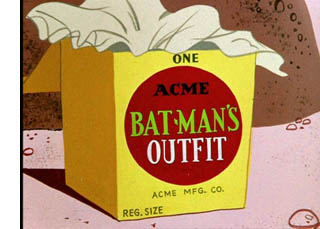 Shock and awe in presentation. The rise of the multiplex meant not only an upgrade in comfort (my back appreciates the tilting seats) but also a demand for big pictures and big sound. Smaller, more intimate movies look woeful on your megascreen, and what’s the point of Dolby surround channels if you’re watching a Woody Allen picture? Like science-fiction and fantasy, the adventures of a superhero in yawning landscapes fill the demand for immersion in a punchy, visceral entertainment. Scaling the film for Imax, as Superman Returns and The Dark Knight have, is the next step in this escalation.
Shock and awe in presentation. The rise of the multiplex meant not only an upgrade in comfort (my back appreciates the tilting seats) but also a demand for big pictures and big sound. Smaller, more intimate movies look woeful on your megascreen, and what’s the point of Dolby surround channels if you’re watching a Woody Allen picture? Like science-fiction and fantasy, the adventures of a superhero in yawning landscapes fill the demand for immersion in a punchy, visceral entertainment. Scaling the film for Imax, as Superman Returns and The Dark Knight have, is the next step in this escalation.
Too much is never enough. Since the 1980s, mass-audience pictures have gravitated toward ever more exaggerated presentation of momentary effects. In a comedy, if a car is about to crash, everyone inside must stare at the camera and shriek in concert. Extreme wide-angle shooting makes faces funny in themselves (or so Barry Sonnenfeld thinks). Action movies shift from slo-mo to fast-mo to reverse-mo, all stitched together by ramping, because somebody thinks these devices make for eye candy. Steep high and low angles, familiar in 1940s noir films, were picked up in comics, which in turn re-influenced movies.
Movies now love to make everything airborne, even the penny in Ghost. Things fly out at us, and thanks to surround channels we can hear them after they pass. It’s not enough simply to fire an arrow or bullet; the camera has to ride the projectile to its destination—or, in Wanted, from its target back to its source. In 21 of earlier this year, blackjack is given a monumentality more appropriate to buildings slated for demolition: giant playing cards whoosh like Stealth fighters or topple like brick walls.
I’m not against such one-off bursts of imagery. There’s an undoubted wow factor in seeing spent bullet casings shower into our face in The Matrix.
I just ask: What do such images remind us of? My answer: Comic book panels, those graphically dynamic compositions that keep us turning the pages. In fact, we call such effects “cartoonish.” Here’s an example from Watchmen, where the slow-motion effect of the Smiley pin floating down toward us is sustained by a series of lines of dialogue from the funeral service.
With comic-book imagery showing up in non-comic-book movies, one source may be greater reliance on storyboards and animatics. Spfx demand intensive planning, so detailed storyboarding was a necessity. Once you’re planning shot by shot, why not create very fancy compositions in previsualization? Spielberg seems to me the live-action master of “storyboard cinema.” And of course storyboards look like comic-book pages.
The hambone factor. In the studio era, star acting ruled. A star carried her or his persona (literally, mask) from project to project. Parker Tyler once compared Hollywood star acting to a charade; we always recognized the person underneath the mime.
This is not to say that the stars were mannequins or dead meat. Rather, like a sculptor who reshapes a piece of wood, a star remolded the persona to the project. Cary Grant was always Cary Grant, with that implausible accent, but the Cary Grant of Only Angels Have Wings is not that of His Girl Friday or Suspicion or Notorious or Arsenic and Old Lace. Or compare Barbara Stanwyck in The Lady Eve, Double Indemnity, and Meet John Doe. Young Mr. Lincoln is not the same character as Mr. Roberts, but both are recognizably Henry Fonda.
Dress them up as you like, but their bearing and especially their voices would always betray them. As Mr. Kralik in The Shop around the Corner, James Stewart talks like Mr. Smith on his way to Washington. In The Little Foxes, Herbert Marshall and Bette Davis sound about as southern as I do.
Star acting persisted into the 1960s, with Fonda, Stewart, Wayne, Crawford, and other granitic survivors of the studio era finishing out their careers. Star acting continues in what scholar Steve Seidman has called “comedian comedy,” from Jerry Lewis to Adam Sandler and Jack Black. Their characters are usually the same guy, again. Arguably some women, like Sandra Bullock and Ashlee Judd, also continued the tradition.
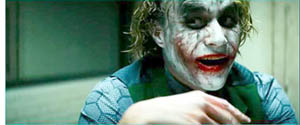 On the whole, though, the most highly regarded acting has moved closer to impersonation. Today your serious actors shape-shift for every project—acquiring accents, burying their faces in makeup, gaining or losing weight. We might be inclined to blame the Method, but classical actors went through the same discipline. Olivier, with his false noses and endless vocal range, might be the impersonators’ patron saint. His followers include Streep, Our Lady of Accents, and the self-flagellating young De Niro. Ironically, although today’s performance-as-impersonation aims at greater naturalness, it projects a flamboyance that advertises its mechanics. It can even look hammy. Thus, as so often, does realism breed artifice.
On the whole, though, the most highly regarded acting has moved closer to impersonation. Today your serious actors shape-shift for every project—acquiring accents, burying their faces in makeup, gaining or losing weight. We might be inclined to blame the Method, but classical actors went through the same discipline. Olivier, with his false noses and endless vocal range, might be the impersonators’ patron saint. His followers include Streep, Our Lady of Accents, and the self-flagellating young De Niro. Ironically, although today’s performance-as-impersonation aims at greater naturalness, it projects a flamboyance that advertises its mechanics. It can even look hammy. Thus, as so often, does realism breed artifice.
Horror and comic-book movies offer ripe opportunities for this sort of masquerade. In a straight drama, confined by realism, you usually can’t go over the top, but given the role of Hannibal Lector, there is no top. The awesome villain is a playground for the virtuoso, or the virtuoso in training. You can overplay, underplay, or over-underplay. You can also shift registers with no warning, as when hambone supreme Orson Welles would switch from a whisper to a bellow. More often now we get the flip from menace to gargoylish humor. Jack Nicholson’s “Heeere’s Johnny” in The Shining is iconic in this respect. In classic Hollywood, humor was used to strengthen sentiment, but now it’s used to dilute violence.
Such is the range we find in The Dark Knight. True, some players turn in fairly low-key work. Morgan Freeman plays Morgan Freeman, Michael Caine does his usual punctilious job, and Gary Oldman seems to have stumbled in from an ordinary crime film. Maggie Gylenhaal and Aaron Eckhart provide a degree of normality by only slightly overplaying; even after Harvey Dent’s fiery makeover Eckhart treats the role as no occasion for theatrics.
All else is Guignol. The Joker’s darting eyes, waggling brows, chortles, and restless licking of his lips send every bit of dialogue Special Delivery. Ledger’s performance has been much praised, but what would count as a bad line reading here? The part seems designed for scenery-chewing. By contrast, poor Bale has little to work with. As Bruce Wayne, he must be stiff as a plank, kissing Rachel while keeping one hand suavely tucked in his pocket, GQ style. In his Bat-cowl, he’s missing as much acreage of his face as Dent is, so all Bale has is the voice, over-underplayed as a hoarse bark.
In sum, our principals are sweating through their scenes. You get no strokes for making it look easy, but if you work really hard you might get an Oscar.
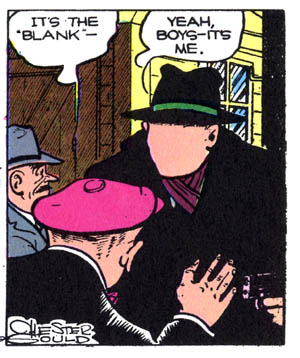 A taste for the grotesque. Horror films have always played on bodily distortions and decay, but The Exorcist (1973) raised the bar for what sorts of enticing deformities could be shown to mainstream audiences. Thanks to new special effects, movies like Total Recall (1990) were giving us cartoonish exaggerations of heads and appendages.
A taste for the grotesque. Horror films have always played on bodily distortions and decay, but The Exorcist (1973) raised the bar for what sorts of enticing deformities could be shown to mainstream audiences. Thanks to new special effects, movies like Total Recall (1990) were giving us cartoonish exaggerations of heads and appendages.
But of course the caricaturists got here first, from Hogarth and Daumier onward. Most memorably, Chester Gould’s Dick Tracy strip offered a parade of mutilated villains like Flattop, the Brow, the Mole, and the Blank, a gentleman who was literally defaced. The Batman comics followed Gould in giving the protagonist an array of adversaries who would even raise an eyebrow in a Manhattan subway car.
Eisenstein once argued that horrific grotesquerie was unstable and hard to sustain. He thought that it teetered between the comic-grotesque and the pathetic-grotesque. That’s the difference, I suppose, between Beetlejuice and Edward Scissorhands, or between the Joker and Harvey Dent. In any case, in all its guises the grotesque is available to our comic-book pictures, and it plays nicely into the oversize acting style that’s coming into favor.
You’re thinking that I’ve gone on way too long, and you’re right. Yet I can’t withhold two more quickies:
The global recognition of anime and Hong Kong swordplay films. During the climactic battle between Iron Man 2.0 and 3.0, so reminiscent of Transformers, I thought: “The mecha look has won.”
Learning to love the dark. That is, filmmakers’ current belief that “dark” themes, carried by monochrome cinematography, somehow carry more prestige than light ones in a wide palette. This parallels comics’ urge for legitimacy by treating serious subjects in somber hues, especially in graphic novels.
Time to stop! This is, after all, just a list of causes and conditions that occurred to me after my day in the multiplex. I’m sure we can find others. Still, factors like these seem to me more precise and proximate causes for the surge in comic-book films than a vague sense that we need these heroes now. These heroes have been around for fifty years, so in some sense they’ve always been needed, and somebody may still need them. The major media companies, for sure. Gazillions of fans, apparently. Me, not so much. But after Hellboy II: The Golden Army I live in hope.
Thanks to Hank Luttrell for information about the history of the comics market.
The superhero rankings I mentioned are: Spider-Man 3 (no. 12), Spider-Man (no. 17), Spider-Man 2 (no. 23), The Dark Knight (currently at no. 29, but that will change), Men in Black (no. 42), Iron Man (no. 45), X-Men: The Last Stand (no. 75), 300 (no. 80), Men in Black II (no. 85), Batman (no. 95), and X2: X-Men United (no. 98). The usual caveat applies: This list is based on unadjusted grosses and so favors recent titles, because of inflation and the increased ticket prices. If you adjust for these factors, the list of 100 all-time top grossers includes seven comics titles, with the highest-ranking one being Spider-Man, at no. 33.
For a thoughtful essay written just as the trend was starting, see Ken Tucker’s 2000 Entertainment Weekly piece, “Caped Fears.” It’s incompletely available here.
Comics aficionados may object that I am obviously against comics as a whole. True, I have little interest in superhero comic books. As a boy I read the DC titles, but I preferred Mad, Archie, Uncle Scrooge, and Little Lulu. In high school and college I missed the whole Marvel revolution and never caught up. Like everybody else in the 1980s I read The Dark Knight Returns, but I preferred Watchmen (and I look forward to the movie). I like the Hellboy movies too. But I’m not gripped by many of the newest trends in comics. Sin City strikes me as a fastidious piece of draftsmanship exercised on formulaic material, as if Mickey Spillane were rewritten by Nicholson Baker. Since the 80s my tastes have run to Ware, Clowes, a few manga, and especially Eurocomics derived from the clear-line tradition (Chaland, Floc’h, Swarte, etc.). I believe that McCay and Herriman are major twentieth-century artists, with Chester Gould and Cliff Sterrett worth considering for the honor too.
You can argue that Oliver Stone’s films create ambivalence inadvertently. JFK seems to have a clear-cut message, but the plotting is diverted by so many conspiracy scenarios that the viewer might get confused about what exactly Stone is claiming really happened.
On the ways that worldmaking replaces character-centered media storytelling, the crucial discussion is in Henry Jenkins, Convergence Culture: Where Old and New Media Collide (New York University Press, 2007), 113-122.
On franchise-building, see the detailed account in detail in Eileen R. Meehan, “‘Holy Commodity Fetish, Batman!’: The Political Economy of a Commercial Intertext,” in The Many Lives of the Batman, ed. Roberta E. Pearson and William Uricchio (Routledge, 1991), 47-65. Other essays in this collection offer information on the strategies of franchise-building.
Just as Star Wars helped legitimate itself by including Alec Guinness in its cast (surely he wouldn’t be in a potboiler), several superhero movies have a proclivity for including a touch of British class: McKellan and Stewart in X-Men, Caine in the Batman series. These old reliables like to keep busy and earn a spot of cash.
PS: 21 August 2008: This post has gotten some intriguing responses, both on the Internets and in correspondence with me, so I’m adding a few here.
Jim Emerson elaborated on the zeitgeist motif in an entry at Scanners. At Crooked Timber, John Holbo examines how much the film’s dark cast owes to the 1990s reincarnation of Batman. Peter Coogan writes to tell me that he makes a narrower version of the zeitgeist argument in relation to superheroes in Chapter 10 of his book, Superhero: The Secret Origin of a Genre, to be reprinted next year. Even the more moderate form he proposes doesn’t convince me, I’m afraid, but the book ought to be of value to readers interested in the genre.
From Stew Fyfe comes a letter offering some corrections and qualifications.
*Stew points out that chain stores like Borders do sell some periodical comics titles, though not always regularly.
*Comics publishing, while not at the circulation levels seen in the golden era, is undergoing something of a resurgence now, possibly because of the success of the franchise movies. Watchmen sales alone will be a big bump in anticipation of the movie.
*As for my claim that film is driving the publishing side, Stew suggests that the relations between the media are more complicated. The idea that the tail wags the dog might apply to DC, but Marvel has made efforts to diversify the relations between the books and the films.
They’ve done things like replacing the Hulk with a red, articulate version of the character just before the movie came out (which is odd because if there’s one thing that the general public knows about the character is that he’s green and he grunts). They’ve also handed the Hulk’s main title over to a minor character, Hercules. They’ve spent a year turning Iron Man, in the main continuity, into something of a techno-fascist (if lately a repentant one) who locks up other superheroes.
Stew speculates that Marvel is trying to multiply its audiences. It relies on its main “continuity books” to serve the fanbase who patronizes the shops, and the films sustain each title’s proprietary look and feel. In addition, some of the books offer fresh material for anyone who might want to buy the comic after seeing the film; this tactic includes reprinted material and rebooted continuity lines in the Ultimate series. Marvel has also brought in film and TV creators as writers (Joss Whedon, Kevin Smith), while occasionally comics artists work in TV shows like Heroes, Lost, and Battlestar Galactica. So the connections are more complex than I was indicating.
Thanks to all these readers for their comments.
Comic-Con 2008, Part 2: Why Hollywood cares
Kristin here-
You can’t picture the typical reader of Variety or the New York Times picking up the latest issue of Superman at the local comics shop. So why is Comic-Con, the annual confab of fans from around the world, gathering so much interest from both mainstream media and the trade press?
The obvious answer is that a growing number of megapictures and TV series are derived from superhero comics and, more broadly, fantasy and science-fiction literature. The chance to see stars and directors on panels, the first look at preview clips–these draw both fans and entertainment reporters.
Recently, the press is suggesting that Hollywood’s presence is becoming dominant at this gathering of self-professed geeks. After going to my first Comic-Con last month, I’m thinking that something else is going on. First, it’s not clear that Hollywood rules the Con. Second, and more interesting, is the question of exactly how Hollywood benefits from being there–or indeed, whether it benefits at all.
Hollywood vs. comics
Michael Cieply’s July 25 article in the New York Times is entitled, “Comic-Con Brings Out the Stars, and Plugs for Movies.” To read it, you would think that Comic-Con is a purely film event. Cieply Refers to Hugh Jackman promoting X-Men Origins: Wolverine, Mark Wahlberg presenting clips from Max Payne, the cast and director of Twilight addressing a squealing crowd of young female fans, and so on. Nary a mention of comics, video games, action figures, collectibles, original artworks, and other items being sold or promoted in the vast exhibition hall, let alone the numerous simultaneous panels going on all day upstairs and the long, sinuous lines of fans awaiting their turn for autographs from artists.
Writing for the Los Angeles Times, Geoff Boucher started his July 28 story, “This is the year they tried to take the comic out of Comic-Con.” The piece is entitled “Comic books overshadowed by the embrace of Hollywood.” A reporter could probably find plenty of people at Comic-Con to deplore the decline of comics’ representation at the event and an equal number to say that the non-Hollywood part of Comic-Con is alive and well.
Boucher quotes two of the former, who tend to be people who have been attending Comic-Con and other such events for decades. Michael Uslan, a comic-book author in the 1970s and now the executive producer of, among others, The Dark Knight, declares, “I think Comic-Con is in danger of having Hollywood co-opt its soul. It’s turning into something new, and you could really see it this year.” Robert Beerbohm, who has sold comics at every Comic-Con since it was first held in 1970, also worries about the trend: “All the Hollywood directors say that they loved comics as a kid, but now they [i.e., the comics] are being pushed off the floor. Where are the next generation of directors going to come from?”
I tend to think that young directors get influenced by such a diverse mix of popular and high cultural works that the putative lack of comics at Comic-Con won’t make much difference. Plus these days the “comics” are often graphic novels, readily available to any future director from big bookstore chains and internet sources.
Avoiding Hall H
Comic-Con has grown hugely over its nearly four decades of existence, and other media have crept in slowly. Hollywood has been prominently represented for years now. Peter Jackson promoted The Lord of the Rings there, and Adrien Brody and Naomi Watts showed up to promote his King Kong. But somehow this year the journalistic zeitgeist seems to have dictated that most writers choose to stress that Hollywood is in danger of taking over the con. Well, it makes for a dramatic story premise.
Admittedly, I’m a Comic-Con newbie. I’m sure to the old hands the creeping presence of films and TV is noticeable and perhaps worrisome. To me the big Hollywood previews were something you had to seek out, and they weren’t that easy to get to. As I mentioned in my first blog on the subject, the ground floor of the enormous, lengthy building is divided into halls A to H. A to G formed one vast open space, and an attendee could trek from one end to the other without going through doors or lobbies. Hall H, where most of the biggest Hollywood previews and panels took place, was entered from a separate door on the outside of the building. The lines to get in snaked in the opposite direction from doors A to G. Entering and exiting the exhibition hall’s lobby through one of those doors, you might not even notice the lines.
The other big “Hollywood” space is Ballroom 20, on the second floor. Anyone going from one part of the building to the other on this level, on the way to the panel rooms or the autograph area, would be likely to pass it.
My sole Hall H experience came when I attended the Terminator Salvation and Pixar previews on Saturday afternoon. The rest of my time at Comic-Con bore no resemblance to what the news stories describe. Apart from Hall H, I moved extensively around the exhibition hall, the various hallways between the panel rooms, through the “sails pavilion” and along the main lobby without having any sense of the big film and television events going on. I occasionally passed Ballroom 20 when there was a long line outside, but even then there was seldom any indication of what the people were waiting for—no banners or posters. (In general, Comic-Con has sold only very limited “signage” outside the exhibition hall. The upstairs hallways outside the panel doors were unadorned apart from small schedule boards.) In the exhibition hall I saw the studio logos hanging above their exhibit spaces and learned to skirt around them to avoid the particularly dense crowds in that area—but it was one area among many in that giant space. I seem to have experienced a different Con from the one widely reported on.
I’m not alone in thinking that Comic-Con is a giant, diverse event that simply has a big Hollywood screening room next door for those who are interested. Marc Graser, who wrote several pieces on this year’s Con for Variety, talked with its PR director, David Glanzer:
“Not every studio has a presentation every year,” Glanzer says. “It’s not an earth-shattering event. Sometimes people read too much into it.”
Yet the irony in all of this is that film- and TV-specific programming makes up less than 25% of the Con’s schedule, Glanzer says. And even on the event’s show floor, studios are overshadowed by comicbook publishers, retailers, videogames and toy companies.
The rest of the panels are educational sessions on how to break into the comicbook biz, for example, that allow Comic-Con to consider itself an educational nonprofit.
In other sources, Glanzer gives the more specific figure for film- and TV-related programming as 22%.
Those educational sessions for budding comic-book creators do make up quite a share of the program. These aren’t just how-to-draw lessons. There was a panel, “Comic Book Law School Afternoon Special: Gone But Not Forgotten!” dealing with intellectual property rights and others on the practicalities of the business. There were also 50-minute “Spotlight” sessions devoted to individual artists like Ralph Bakshi and Lynda Barry. The Eisner Awards ceremony celebrated accomplishment in the comics world.
Camping in Hall H
Why do journalists covering Comic-Con tend to stress Hollywood so much? I assume because the previews and panels are where the big stars are. They and their forthcoming films are the big news, the buzz that makes it worthwhile for magazines, newspapers, and blogs to spend the money to send their reporters or hire free-lancers. Most reporters experience that other “Hall H” con that I only visited once. I saw Anne Thompson at the “Masters of the Web” panel on Thursday morning, and she duly blogged about it. Still, most of the many Comic-Con stories posted on her Variety blog by her and other reporters were on the films and TV shows.
And why not? The big entertainment reporters get access to the major talent for short interviews, and their photographers can get up close for glamorous shots to use as illustrations. That’s no doubt what the largest portion of their readership or viewership is interested in. Attending the Con is an efficient way of generating a lot of copy.
Nevertheless, it doesn’t hurt to note that Hall H seats 6500 people, dozens, perhaps hundreds of them the entertainment reporters and bloggers. That’s out of 125,000 attendees who bought passes and probably tens of thousands more who were exhibitors, “booth babes,” or panel presenters. Granted, people circulated in and out of Hall H, though my impression is that some people stayed there much of the time. If sheer numbers of fans were to determine news coverage, the other facets of Comic-Con would get more attention than they do. But it’s the stars.
What’s in it for the studios?
The answer to that question might seem self-evident: publicity, and lots of it. The situation fuels itself. As more reporters from bigger outlets come to Comic-Con, the studios get more valuable publicity at a relatively small cost. (USA Today’s July 28 wrap-up occupied nearly a page and a half of the print edition.) And as more studios send previews and big stars, more news sources will find it worth sending their main reporters. In fact, perhaps this year the situation reached saturation. Hollywood studios filled all the possible slots in the two large halls, and in some cases big news outlets sent teams of reporters. That might be what gave both studio execs and reporters the impression that Hollywood is steamrolling the rest of the Con.
Publicity is all very well, but in the August 1 issue of The Hollywood Reporter, Steven Zeitchik questions whether it’s really worth all the fuss to preach to the converted. He notes the growth of the big studios’ efforts to impress fans: “On its face, this shouldn’t be the case. A brand’s cult following isn’t a very large number, and it’s also a group already inclined to like and spend money on a product, which by most marketing logic is exactly the group you should spend the fewest resources on.”
Sure, the Comic-Con previews may impress fans who are assumed to be tastemakers, particularly in the blogosphere. Zeitchik comments, “And if the tastemaker effect doesn’t happen, the strategy loses its teeth. One director who’s had repeated visits to Comic-Con noted just before he went to this year’s convention that ‘The total number of people in the blog world is probably only a few hundred thousand, and as much as they might hate to hear it, for most movies that’s not going to make the difference between a success and a failure.’” Zeitchik points out that the Speed Racer preview at the 2007 Con was cheered, but that didn’t mean that a lot of fans bought tickets to the film itself. The wider public stayed away.
Yet surely the studio suits know all this, and they keep providing glimpses of films and series to come. What other advantages do they perceive?
A Comic-Con preview can be a chance not only to woo fans but to get clues that might help in the general publicity campaign. Focus Features president James Shamus, who previewed Hamlet 2 at Comic-Con this year, views the process as a chance to get instantaneous feedback that might help later in promoting a film: “It’s the start of an ongoing dialog. It doesn’t just start and end there. It’s not a thumbs up or thumbs down because some guy didn’t like your poster.”
Many studio executives also still believe in the viral quality of fan buzz on the internet. Lisa Greogorian, the executive vice-president of marketing for Warner Bros. Television, assesses past years’ previews of Chuck, Pushing Daisies, and The Sarah Connor Chronicles: “We saw an immediate impact online. Word of mouth is now one individual impacting a couple hundred individuals who can impact thousands. Social networking has allowed us to empower one fan to impact thousands of potential viewers.” (Both executives spoke to Marc Graser for a July 11 Comic-Con preview in Variety.)
I emailed James, who is an old friend of ours, about the subject. He pointed out that while the blockbusters may have a pre-sold audience, smaller films like Shaun of the Dead can create momentum at Comic-Con. Moreover, there are a lot of blogs out there now, and studios monitor the more important ones to help shape their own publicity efforts.
A Comic-Con presence often, however, is not simply a matter of persuading fans to watch a film or TV series. Sometimes major negative buzz began to surround a film from a few bad online comments based solely on the Con previews. Wooing the fans with stars and footage can be a way to prevent that negativity from getting started—or a big reason for some studios not to preview a film at the Con.
One factor that doesn’t get mentioned in the press coverage of why the Hollywood studios bother with Comic-Con previews is that this event in effect provides them with huge, low-cost press junkets.
The modern press junket for a tentpole film is typically an expensive affair. The studio pays for dozens, maybe hundreds of reporters to travel to a single spot. It may be as bland as a rented hotel conference room, or it may be set in some more picturesque locale. At Cannes in 2001, New Line held a big junket for The Lord of the Rings at a hillside chateau with a spectacular view. Other junkets might be on-set, at a studio where the film is still shooting. The studios have to shell out for the reporters’ hotels, give them a per diem, and supply a reasonably impressive swag-bag. And there isn’t just one junket, but several in the course of publicizing a major release.
With Comic-Con, the studios have a whole bevy of reporters, many of them famous names in their own right, delivered to them at their employers’ expense. There are rows up front in Hall H reserved for them They sit through preview session after preview session for four days and generate a huge amount of publicity. Certainly there are expenses involved for the studios, but cutting together a few scenes or a random collection of finished shots together with a temp music track doesn’t cost a lot, and the actors don’t get paid extra for their publicity appearances. Transportation might be a relatively simple matter of sending whatever stars happen to be in Los Angeles in a limo down to San Diego. James specified to me that Comic-Con is “a very cost-effective” way of bringing the talent from a film together with fans to gauge how they interact.
I suppose for the reporters, the chance to attend what is in effect a whole passel of press junkets in one stretch saves a lot of time on airplanes.
Oh, yes, the comics
Some stories do stress the comics. Not surprisingly, Publisher’s Weekly printed an excellent preview that talked about the comics and graphic-novels companies that would be present. The author also pointed out that the connections between comics and films are getting closer, what with all the adaptations that have been made or are in the pipeline. The article quotes comics author Steve Niles (30 Days of Night) as saying, that the Con is “crawling with producers now, which means some of the up-and-comers have a chance to get someone to notice their book.”
USA Today ran a story that analyzed the recent trend toward comics-based movies quite carefully. Author Scott Bowles discusses the trends toward darker stories and heroes who aren’t conventional heroic, such as Hancock and the Watchmen. The story also discusses whether this trend indicates that the superhero genre is nearly over or just reaching a more imaginative stage.
Bowles also points out that the traditional notion of the Con as largely frequented by fanboys is no longer accurate. This year nearly 40% of the fans were female.
Costumes and the press
Naturally journalists with cameras make a beeline for costumed Comic-Con attendees. They stand out in the crowd, they seem to these journalists to epitomize the fan sensibility, and they are delighted to pose at any length for photos. (Anne Thompson’s blog has a sampling posted.) Many of them have very impressive costumes and put on little skits or tableaux in the hallways. There’s a “masquerade” competition with cash (up to $150) and merchandise prizes on Saturday night.
[Added August 11: David Glanzer kindly emailed me to compliment me on this entry. He informed me that roughly one percent of fans attending Comic-Con come in costume. Not that either he or I have anything against costumed fans. On the contrary, I enjoyed seeing them, and obviously they were having a terrific time. But some journalists adopt a definitely mocking tone, and even those who are respectful tend to mislead the public about the attendees at the Con in general.]
But most attendees are content to declare their interests on their T-shirts, as I did, and their shopping bags. Again, that doesn’t make for good copy or images. The photos at top and bottom show what I saw much of the time in the exhibition hall. These people are not likely to be approached by journalists, though these days they might have a questionnaire thrust into their hands by a sociologist or ethnographer trying to figure out what makes fans tick.
If you have to ask …
For my account of things and event relating to The Hobbit and The Lord of the Rings at Comic-Con, see here.
Games cinephiles play
From DB:
The Europeans have long been fascinated by the subject of cinephilia. The French supplied not only the word but the most outstanding instances, from the founding of Cahiers du cinéma to the passions of the Nouvelle Vague. (1) In the last decade particularly, French critics have often returned to the subject–worrying, for instance, that home video might have changed or even decimated cinephilia–and this has led critics from other countries to join in.
I was reminded of how strongly the idea persists when, at Il Cinema Ritrovato this year, I was invited to sit in on one of several lunches at which critics and historians talked about the subject. The discussion consisted mostly of recollections of the guests’ first encounters with cinema, of the films that affected them most powerfully, of the film-related activities they engaged in during their salad days. Some of us hadn’t done this exercise in autobiography before, but others had had practice. Jonathan Rosenbaum and Eric de Kuyper had both written a fair amount about the sources of their affinity for film. (Sometimes I feel I remember Jonathan’s life better than my own.)
What is cinephilia? Literally, the love of film. But everybody likes, even loves film, no? The term “cinephilia” connotes an overwhelming passion for film, even an obsession about it. And not just particular films. I meet civilians all the time who are devoted to their favorites—The Godfather, The Princess Bride, The Matrix. But they’re not cinephiles. So is it just a matter of quantity? Is it just that the cinephile enjoys a great many movies? Partly, but there’s still more to it.
The cinephile displays symptoms of cinemania, as chronicled in the film of the same name. If you haven’t seen it, Cinemania tracks five people who organize their lives around watching movies. As I watched it, some of my reactions ran to “Wow, that is really hard-core,” but every now and then I thought: “Well, that‘s not so weird. I do that.” So I see the similarities.
Most obviously, both the cinephile and the cinemaniac show symptoms of compulsiveness. Each one makes lists, checks off titles seen, plans a day of moviegoing with care. When visiting a new city, s/he first scans the cultural scene for what’s playing. Both types of film lover are strict—no pan-and-scan, no colorization, no dodgy projection. Either type might have a weblog or a diary or just patient friends. If s/he has friends.
But I do see differences. For one thing, most cinemaniacs like only certain sorts of movies—usually American, often silent, sometimes foreign, seldom documentaries. Do cinemaniacs line up for Brakhage or Frederick Wiseman? My sense is not.
Cinephiles by contrast tend to be ecumenical. Indeed, many take pride in the intergalactic breadth of their tastes. Look at any smart critic’s ten-best lists. You’ll usually see an eclectic mix of arthouse, pop, and experimental, including one or two titles you have never heard of. Obscurity is important; a cinephile is a connoisseur.
The real crux, I think, is this. The cinephile loves the idea of film.
That means loving not only its accomplishments but its potential, its promise and prospects. It’s as if individual films, delectable and overpowering as they can be, are but glimpses of something far grander. That distant horizon, impossible to describe fully, is Cinema, and it is this art form, or medium, that is the ultimate object of devotion. In the darkening auditorium there ignites the hope of another view of that mysterious realm. The pious will call Cinema a holy place, the secular will see it as the treasure-house of an artform still capable of great things. The promised land of cinema, as experimentalists of the 1920s called it: that, mystical as it sounds, is my sense of what the cinephile yearns for.
This separates the cinephile from the lover of novels or classical music. They love their art, I suspect, because of its great accomplishments. Who with literary or musical taste would embrace the subpar novel or the apprentice toccata? But cinephiles will watch damn near anything looking for a moment’s worth of magic. Perhaps this puts cinephiles closer to theatre buffs. They too wait hopefully for the sublime instant that flickers out of amateur performances of Our Town and Man and Superman.
That’s also why I think that the cinephile finds the desert-island question so hard to answer. What movies would I want to live with for the rest of my life? All of them, especially the ones I haven’t yet seen.
Another difference: Fussiness and solitude. The cinemaniac has a favorite seat, even if it’s way off to the side. To secure it, the cinemaniac shows up early and tries to be first in line. Your average cinephile isn’t so picky about where to sit, and so may slip in at the last minute. While waiting for the show to start, the cinemaniac seldom acknowledges others; a book is the faithful companion. But the cinephile is, if not extroverted, at least gregarious and wants to talk with other cinephiles.
What sort of talk? I’m glad you asked.
Cooperative games: Playing well with others
Jules and Jim leave a screening.
Jules: Great movie!
Jim: Yeah, great!
Jules: Well, see ya.
Jim: Yup, later.
This is the minimal, polite cooperative game. When the energy level is cranked up, you get something like this.
Jules: Great movie! I love M*x *ph*ls.
Jim: God, yes. Those camera movements knock me out.
Jules: But then there’s R*n**r too!
Jim: God, I love R*n**r. And M*z*g*ch*–there’s a man for camera movements.
Jules: My man! M*z*g*ch* is just terrific.
This can go on indefinitely. To get a sense of how special cinephiliac enthusiasms are, imagine littérateurs talking about Keats, Shelley, Coleridge, and iambic pentameter in these terms.
A cooperative game can go a little further.
Jules: What a fantastic movie!
Jim: Yes, fabulous. M*nn*ll* movies get better and better, the more you see them.
Jules: I completely agree—except for The S*ndp*p*r.
Jim: Yeah, that’s kind of weak, but it’s got some good points.
Jules: Really? I haven’t seen it in twenty years.
Jim: I have a pretty good copy off Turner. Let me dub it and send it to you.
Jules: That’s really nice of you.
Even if Jim never sends the disc, he has played the game charitably and Jules has accepted graciously.
Jim: What a terrific movie.
Jules: I wasn’t so impressed. Want to grab a coffee and talk about it?
Jim: Good idea!
This is probably the optimal way to play Cinephilia cooperatively.
But many cinephiles want to play rougher. The extreme option is flat-out disagreement, usually expressed in terms that bluntly doubt the competitor’s sanity, intelligence, or good will. I won’t dwell on this abrasive strategy here. There are stealthier ways to go.
Competitive games: Upsmanship
Jules and Jim leave a screening.
Jules: I loved it. What did you think?
Jim: Well. . . Have you seen earlier films by H*ng S*ng-s**?
This is an opening gambit. If Jules says no, then Jim can say something like: It’s really one of his weaker movies or His films get worse and worse. Now Jules would be playing defense, on unfriendly terrain. If he hasn’t seen the other films, the comparison-strategy will be his undoing. So:
Jules: Yeah, I’ve seen all of them. I thought that this was a strong one.
Now Jim can fight to at least a draw. Maybe Jules was bluffing and hasn’t seen all the films; or maybe Jim remembers them better.
Jules has used what we can call the breadth strategy: I’ve seen more than you. This need not bear only on other films; it can work along other dimensions.
Jim: I was so impressed by St*g* Fr*ght, but I never heard anybody refer to it among H*tch’s best.
Jules: Well, in the critical literature it’s often considered a masterpiece. Have you read . . .?
Or:
Jules: Yes, it’s a great movie, but what a terrible print! The reel ends were chopped off, and there were splices all the way through. I remember seeing a pristine print at the Director’s Guild Theatre. [The haymaker:] Jane Wyman was there to talk about it.
With a silent film you can extend the strategy to multiple versions: I remember a MoMA screening that ran an extra half-hour or The DVD from Austria fills in the missing scenes with stills. Oh, you didn’t know there were missing scenes…? Jim doesn’t have many options here.
If Jules sticks to the breadth strategy, this can go on quite a while. Once I got cornered after a friendly critic asked me about 1930s Ozu. Yes, I’d seen them all. Naruse? Yes. Shimizu? Quite a lot. I held my own, but then he changed up his pitching rhythm: “And how about 1930s English comedies? No? Oh, you must see them—they’re wonderful.”
Akin to the breadth approach is the longevity strategy, aka I was here first. We old guys like to use this. It can get pretty brutal.
Jules: Great movie!
Jim: First time you saw it?
Jules: Um, yeah.
Jim: It gets better on multiple viewings. I liked it when I saw it in 1971. In fact, I liked it so much I wrote about it for Sight & Sound. Let me send you a copy of the essay.
Jules: Um…thanks…
There’s also the depth strategy. Here the player goes very specific, invoking details that suggest sensitivity and massive memory power.
Jules: Great movie!
Jim: You said it. I especially liked the scene when the camera tracks sideways, picking up the back of the guy who’ll turn out to be so important at the end.
Jules: Yeah. . . Actually, I didn’t notice that.
Jim: You didn’t? Gosh, that’s the key to the whole movie. It sets up the last scene beautifully. Of course there’s also that killer opening line.
Jules (who doesn’t even remember the opening scene): Yeah, that was really effective.
Jules lost, and Jim knows it.
Another strategy relies on eloquence. Both Jules and Jim are evenly matched on range and depth and longevity, but Jules has the edge in using language.
Jules: What’d you think?
Jim: I liked the opening shot.
Jules: Me too. Most long-take crane shots look pretentious, but this one had a sinuous grace that’s hard to achieve on location.
This strategy can be amped up into philosophical disquisition that usually sounds better in French but can occur in English too.
Jim: I just don’t see why people take W**dy *ll*n seriously. Cr*m*s *nd M*sd*m**n*rs is heavy-handed in its metaphors of blindness and sight.
Jules: What’s remarkable about W**dy is the way his metaphors hover between the banal and the extraordinary. They’re at once familiar and unfamiliar, both distant and near. They lie, we might say, in a zone of zigzag indeterminacy.
Okay, this plays better on the page than in conversation, but I have encountered it occasionally face to face. It’s a hard serve to return. Resorting to I just don’t know what that means usually makes you look dumb, whereas Do you buy effluvia like that in ten-gallon drums? would be considered hostile.
Then there’s the insider strategy.
Jules: Solid movie, but a little choppy.
Jim: Yeah, the director sent me a rough cut on DVD a few months ago. Looks like she dropped a lot. And the producer’s son attempted suicide, which probably screwed up the whole project.
Advantage: Jim.
What we talk about when we talk about talk
I’ve taken face-to-face dialogue as my default, but you can find these strategies at play in those monologues we call film criticism. The maneuvers are usually a bit subtler, though. For instance, the longevity strategy often surfaces guilelessly, as a homey touch of autobiography. Some critics like to start their pieces with a chatty narrative recounting how they learned about this film—that is, way before you, loser.
And of course these strategies are all over forums and chat threads. In those settings the players can be anonymous and can loose a barrage that they might hesitate to launch in person.
One last question: Are these games for boys only? Is cinephilia itself defined as a guy’s thing? In my experience, no, not wholly; but mostly. Have women opted out? Do they play it differently? I might have to recast my dialogues in order to include Catherine.
In any case: Substantively speaking, this is a minuet. Jules’ claims might be right or wrong. Ditto Jim’s. Any of the competitive strategies can produce information and ideas. We just have to remember that lots of life is about playing games.
And remember that you can always change the subject to sports or rock and roll. No one-upsmanship in those domains!
(1) Antoine de Baecque’s entertaining La cinéphilie: Invention d’un regard, histoire d’une culture 1944-1968 (Paris: Fayard, 2003) has become the standard history of this tendency.
Comic-Con 2008, Part 1: The Con Experience
Kristin here–
From July 23 to 27, I was at Comic-Con for the first time. For the past few years I have contemplated attending, since it is the largest pop-culture fan event in the world. Last year the Con sold out its 125,000 tickets for the first time, and that feat was repeated this year. Comic-Con has become important for the launching of blockbuster fantasy and sci-fi movies. Ian McKellen, on break from playing Gandalf, made a surprise appearance there in 2000 to promote the first X-Men film. Innumerable franchise items for big-budget films have made their debut at the Con.
This year I received an invitation from TheOneRing.net to participate on the site’s first Comic-Con panel in five years (i.e., since 2003, the year of The Return of the King). My fellow panelists were Chris “Calisuri” Pirrotta (co-founder of TORN), Cliff “Quickbeam” Broadway (long-time contributor to the “Green Books” section), and Larry “MrCere” Curtis (contributor to TORN and coordinator of many line parties for the trilogy). That was the extra push that made me decide that this was the year to take the plunge. (See MrCere’s coverage of Comic-Con here, here, and here.)
Coincidentally, pop-culture expert Henry Jenkins was also attending his first Comic-Con. We never spotted each other during the Con itself, but after it ended on Sunday afternoon, we got together for a conversation about our thoughts and reactions. Henry’s now on vacation and wisely not checking email, but I’m going to write up another entry with lengthy excerpts from that conversation. Once I get a chance to run the result past Henry and get his suggestions, probably in a couple of weeks, I’ll be posting that as well. Here I’ll just give an account of my own experiences and what I learned about Comic-Con. I’ll also be blogging specifically about the news-media coverage of the event.
Four-day passes were already sold out by the time our panel was officially accepted (early June), but TORN took care of reserving “Professional” passes for the group. The basic passes seem to be Four-Day, Professional, Press, Exhibitor and One-Day. Eventually I received an email confirmation, complete with barcode to be scanned when I picked up my pass.
Comic-Con takes place every year at the San Diego Convention Center. There’s no way a photo or even a bunch of photos can convey how big the place is. The space centers around an exhibit hall divided into sections A to H, corresponding to the lobby doors through which one enters. I assume these can be closed off from each other for smaller events, but in this case the entire space apart from Hall H was open. The total exhibition space is 525,701 square feet, with Hall H being 64,842 of that. (More about Hall H later.) David and I live in a large house, but this exhibition hall has about 100 times more floor space.
There’s only one other floor, apart from the mezzanine. The mezzanine was fairly small and taken up by gaming and some small booths which I didn’t investigate. On the second floor are the meeting rooms, varying considerably in size but adding up to 204,114 square feet. The “Sails Pavilion,” a large, column-free open space, is a further 90,000 square feet. That’s where people lined up to get the autographs of major guests, and where the freebies tables and “portfolio review” area were set up. Apart from all that, there are large halls and lobbies where lines form, people socialize, and snack carts sell expensive food and drink. These zones total 284,494 square feet. Rumor has it that after its contract with the Convention Center ends in 2012, Comic-Con may seek an even bigger venue, most likely in Las Vegas or Los Angeles.
Wednesday evening (July 23), there was a three-hour preview for anyone with a pass for the entire event. Arriving at the Convention Center was an overwhelming experience. Thousands of people were heading for the same place, and tens of thousands already there in line. I arrived at the building and saw vast lines on either side of me along the sidewalk. The one to the left seemed to stretch to the horizon; the one to the right looked somewhat less daunting.
Apparently newbies at Comic-Con commonly get into a line, wait until they reach the front, and realize that they were supposed to be in the other one. Luckily I had arrived at about the mid-point of the building and noticed that the big line was for people picking up purchased four-day passes. The other was for professionals and press. After a short hike, I took my place at the end. The wait was enlivened by people constantly pausing and asking which line this was. Occasionally fans in costume passed by, though these represented a much smaller portion of the crowd than the media would lead us to believe.
The wait seemed long but was probably only about 25 minutes. Once I got inside, the registration process 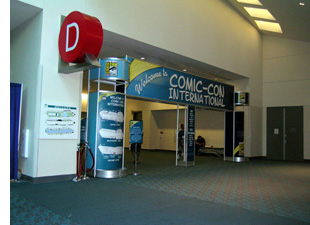 was speedy, with the barcode read and a badge generated and slipped into its plastic case in the blink of an eye. There were no events scheduled that night. It was simply an opportunity to get a look at the exhibition hall, with its thousands of booths and, in the case of the big companies, display areas. Familiar logos were everywhere, and the place stretched out further than one can see.
was speedy, with the barcode read and a badge generated and slipped into its plastic case in the blink of an eye. There were no events scheduled that night. It was simply an opportunity to get a look at the exhibition hall, with its thousands of booths and, in the case of the big companies, display areas. Familiar logos were everywhere, and the place stretched out further than one can see.
I mostly spent the evening checking out the companies related to The Lord of the Rings: Weta Workshop, Sideshow Collectibles, and the tiny booth shared by TheOneRing.net andSlave Boy Films (which produces fan-related video, mainly for websites). I was to do three one-hour signings there in the course of the Con, and it became my pied à terre for the duration of the event. (Thanks to producer Justin Sewell and his team for their hospitality!) I also visited the New Line display, but it was mainly there to sell DVDs of Harold and Kumar Escape from Guantanamo Bay. Sure, people could order it online, but the official release date wasn’t until July 29—two whole days after Comic-Con ended.
(I’ve written up an account of LOTR and The Hobbit at Comic-Con on my “Frodo Franchise” blog.)
Many types of activities go on simultaneously. There are continuous movie and television previews with stars, directors, and/or writers present. There are autographs to be had, with the most famous people signing in the Sails Pavilion (above) and others at booths in the exhibition hall. (I spotted Marcia Wallace, aka Mrs. Crabapple in The Simpsons, signing at one table.) There are things to be bought, though numerous small promotional items are given away. There are panels and artists’ lectures to attend. There are open spaces in which costumed fans can perform or pose for pictures. Aspiring comics artists can show their profiles to representatives from big publishers like Dark Horse. Gamers can try out previews of forthcoming games. Lots of socializing goes on. After the Harry Potter fandom panel ended, I saw the owners of The Leaky Cauldron meeting ardent fans whom they had only known online up to that point. In short, one cannot possibly do and see more than a small fraction of what happens.
Apart from my signing sessions, I concentrated on panels. I was afraid from the long line that I would get shut out of the “Masters of the Web” panel on Thursday morning, but I got in easily—and indeed, throughout the event I didn’t get shut out of anything, though I didn’t try often to get into the big Hollywood previews. The panels, by the way, start at the civilized hour of 10 am. Those of us taking the shuttle buses from distant hotels could still get up at a reasonable time, get breakfast, and make it to them.
Our TORN panel took place on Friday morning. Not everyone who wanted to attend could get into the  room. Apparently one fan who was shut out got unruly and had to be subdued by security staff! Those who did get in were an enthusiastic bunch, and we spent the session speculating on casting and on possible approaches to adapting The Hobbit and especially to writing the mysterious “Film 2” that is to create a “bridge” covering the sixty-year gap between The Hobbit and The Lord of the Rings. Judging from the applause, Martin Freeman (familiar in this country mainly as Declan in Shaun of the Dead) would be a popular choice for Bilbo. He does look like he would make a plausible hobbit. My suggestion of Mark Ruffalo for Thorin should definitely be taken seriously by the filmmakers.
room. Apparently one fan who was shut out got unruly and had to be subdued by security staff! Those who did get in were an enthusiastic bunch, and we spent the session speculating on casting and on possible approaches to adapting The Hobbit and especially to writing the mysterious “Film 2” that is to create a “bridge” covering the sixty-year gap between The Hobbit and The Lord of the Rings. Judging from the applause, Martin Freeman (familiar in this country mainly as Declan in Shaun of the Dead) would be a popular choice for Bilbo. He does look like he would make a plausible hobbit. My suggestion of Mark Ruffalo for Thorin should definitely be taken seriously by the filmmakers.
Other panels I attended involved the Disney “story process,” Sideshow and Marvel toys, and HP fandom. I heard Tolkien artist John Howe’s and comics master Lynda Barry’s talks, definitely two of the highlights of the Con for me. I had long loved John’s Tolkien illustrations and had corresponded with him during the writing of The Frodo Franchise, and it was a huge treat to get to meet him in person—and find that he had read and admired my book. Immediately we were talking like old friends.
Arriving early for Lynda’s talk, I sat through the end of a presentation on an animated series that I had never heard of. During this, Lynda came in and happened to sit down right next to me! (No one who has seen her self-portraits in her comics could fail to recognize her.) I hesitated to ask for her autograph, since some people don’t like to be bothered when they’re about to go onstage. When someone else asked and she didn’t seem to mind, I took my chance. I introduced myself as a fellow Wisconsinite, and she was most charming about signing my program. A good thing, too, since I didn’t figure out her schedule of autograph sessions at the Drawn and Quarterly table until after they were over.
The only disappointing panel was “The Culture of Popular Things: Ethnographic Examination of Comic-Con.” The panelists were a bunch of undergrads (and one grad students) doing a class project which consisted of interviewing exhibitors and fans on various subjects! I’m sure the students are smart and enthusiastic, but they didn’t belong on a panel. If Comic-Con organizers want to add an academic thread—and given the miniscule attendance at these events, I don’t see why they would—they should find some pop-culture experts to make up the panels.
[August 2: I have heard from Dr. Peter Coogan concerning my remarks on the panel “The Culture of Popular Things: Ethnographic Examination of Comic-Con 2008.” He offers some information about the Comic Arts Conference.
The CAC, which has been associated with the Comic-Con since 1992 and a formal part of the Comic-Con since 1998. We run four panels per day for over 20 hours of programming and are one of the largest programming tracks at Comic-Con. Last year the CAC was a small part of the successful argument that the Comic-Con made against San Diego’s attempt to get it reclassified as a for-profit corporation in terms of the rate it would be charged for city services.
Regarding attendance, the CAC was originally located down in room 17 (about 80 seats), but moved up to 7A (about 150 seats) after a few years, and last year to 30AB (about 200 seats). We have consistently filled or overfilled our space, and so have been rewarded with ever larger venues. Attendance was down at CAC panels this year, as it was at many non-media panels across the con. Because of the increased attendance at the con, the lines for the larger Hollywood panels have increased, and attendees, paradoxically, are less free to attend other panels because of all the time they spend waiting in lines.
No doubt I generalized too much on the basis of one panel, for which I apologize. More information on the CAC can be found at its Website.]
The exhibition hall, previews, and panels officially end at 7 pm. Films are screened at night, but I didn’t go to any of them. The main evening events are parties put on by big studios and manufacturers at hotels and screenings held by the studios in local movie theaters. I had a sample of each.
As a member of the TORN panel, I got invited to the Gentle Giant/ Lucasfilm/ Weta/ Sideshow party on Friday evening. I expected that there would be some sort of promotion for upcoming films and products, but there wasn’t anything at the party itself. An adjacent room held a large stack of swag-bags, but I didn’t think I would want to haul home most of what was in them, so I never found out what they contained. I had another chance to talk with John Howe, then briefly with Richard Taylor, and then went off to get a solid eight hours in preparation for the next day.
One of the films being shown in its entirety was Hamlet 2. Our good friend James Shamus of Focus Features got me onto the VIP/Press list, so on Saturday night I was off to the Gaslamp 15 multiplex. The film, which was a hit at Sundance this year, is an amusing and cheerily offensive film which has the potential to be one of this year’s indie sleepers. Director-writer Andrew Fleming, co-writer Pam Brady, and star Steve Coogan were there for a Q&A after the screening. It was definitely a more relaxed and personal session than the one I witnessed for a big studio films, where the guests were tiny dots in the distance and had to be viewed on giant TV screens.
That one preview and Q&A that I witnessed was for Terminator Salvation, which I had sort of assumed that I would miss. I had been avoiding the giant Hall H, where the big studios held their promotional events, because I had heard horror stories about hours waiting in line for one of the 6500 seats. There was plenty to do elsewhere. But I definitely wanted to see the 2:30 Pixar presentation of scenes from upcoming features Bolt and Up. That was at I decided to go early and get in the Pixar line just after Terminator Salvation started at 1:15.
It turned out that there was in fact just one line for Hall H, moving continuously as seats became available. This makes it difficult to gauge when to queue up for a specific event. That line snaked from the entrance across the plaza and made several long loops across the grass. Some people had settled in for lunch. But at about 1:20 we began to move surprisingly quickly. Turned out that the Terminator Salvation show was running a bit late, and I made it just as the preview reel started. It looked like it might be good, though my ears hurt for two days afterward (especially since they showed it again at the end). Director McG and some of the actors held a Q&A afterward—mostly the usual stuff about how wonderful it was to be working with each other. The high point came when a young Asian-American man from the audience asked a question in a perfect “Arnold” voice. He was called up to the stage to help field questions, keeping up the Arnold imitation flawlessly. By the way, Christian Bale (starring as John Connor) wasn’t there, though maybe if he had showed up, he could have avoided a spot of trouble he got into in London a few days earlier.
The Pixar session was a double preview. Co-directors Byron Howard and Chris Williams introduced some lengthy clips from Bolt, to be released November 26. It’s about a dog who plays a super-dog on TV and thinks he really has super powers. The footage cut together storyboard images, unrendered animation, and finished shots, which the audience didn’t seem to mind in the slightest. We’re used to seeing DVD supplements on pre-viz or storyboarding, but to see them all mixed together and edited into sequence, the way the filmmakers themselves see them during post-production, is a rare treat.
Then it was co-director Peter Docter’s turn to introduce Up. This sounds like one of the odder Pixar premises: a 78-year-old man avoids life in a nursing home by tying a giant bunch of helium balloons to his house and flies it to South America, discovering a stowaway boy and ending up in the jungle. The footage shown looked charming. Up is due out May 29. What with WALL-E this summer and these two coming soon, it looks like Pixar is managing to pick up the pace of production to more than one feature per year.
Hall H is essentially impossible to photograph. It’s too dark to shoot without flash, and flash only lights up a small area. To give a sense of scale, though, that orange rectangle near the center of the photo is the stage where the celebrities sit for their sessions. Sitting near the back, I could see them only as small dots, except on the monitors.
On Sunday I wandered around the exhibition hall, which I hadn’t really explored up to then. It’s divided into general sections by type of display. There’s an aisle for upcoming video games; that round thing in the photo at the right is the Electronic Arts sign. Gamers crowded it to try out the new titles. Artists’ Alley is where independent artists and aspiring artists can rent small display tables. Despite the proliferation of media publicized and sold at Comic-Con, comics still command a substantial portion of the floor. Dealers may offer old comics, original artwork, animation cels, and posters. Henry was delighted to find and purchase an original newspaper page with a well-preserved Winsor McCay comic-strip on it.
general sections by type of display. There’s an aisle for upcoming video games; that round thing in the photo at the right is the Electronic Arts sign. Gamers crowded it to try out the new titles. Artists’ Alley is where independent artists and aspiring artists can rent small display tables. Despite the proliferation of media publicized and sold at Comic-Con, comics still command a substantial portion of the floor. Dealers may offer old comics, original artwork, animation cels, and posters. Henry was delighted to find and purchase an original newspaper page with a well-preserved Winsor McCay comic-strip on it.
The big studios have large display areas for films and TV shows. Aisles around them seemed always to be choked with people, I gather getting autographs from cast members. I never did get close enough for a good look, but obviously these booths are very popular.
Action and collectible figures are represented, there’s an area for comic and graphic-novel publishers, such as Drawn and Quarterly.
Overall I enjoyed Comic-Con. I don’t think it will be one of those events I long to attend every year, but I would like to go back. Presumably in a year or two publicity for The Hobbit will start showing up at the Con, and that I definitely would like to see.












